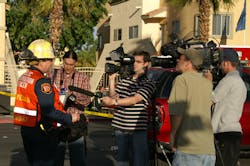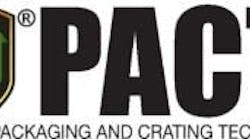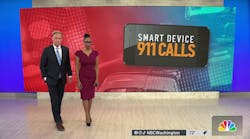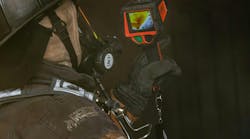Public information officers (PIOs) often need to give interviews during or after an incident at the location where the event is occurring or has occurred. While this can be a common occurrence in some areas, it is important that you always prepare for these interviews and take certain precautions. In this article, I will focus on interviews that occur during an incident in progress and the special precautions required.
Understand the basics
Incidents are usually conducted under the direction of an incident commander (IC). The PIO is a member of the IC’s command staff in charge of receiving and disseminating information. Dissemination of information is usually done through the media.
Over the past few years, the definition of “the media” has changed. In the past usually only major newspaper, TV or radio crews responded to an incident. With the recent growth of social media, there are many more media outlets showing up during an incident—smaller newspapers, bloggers and streaming outlets. They all need to be treated the same; they are all media.
Where to begin
Your job as a PIO begins when you are first notified of the incident. Take note of the time of call, type of call, address and other factors that will be important. While responding to the scene, monitor radio traffic to follow the progress of the incident. Inform the IC that the PIO is responding so if the media arrives before you do, they can advise the media you are on the way.
Location, location, location
When you arrive on scene, establish a media staging area. This is where the media will park their vehicles and meet with you. Notify all the media of the location, and inform them that it is the only place where they can obtain information and where interviews will be conducted. It is better to have them in one area instead of spread out over a large area.
The most important factor to consider during interviews at working incidents is keeping the media safe. That responsibility falls on you as the PIO. As such, this should be your first consideration when selecting the location of the staging area. Select a suitable location so both first responders and the media can access the staging area with ease. Take into account that the incident may escalate and expand. As such, it is better to be a farther distance from the scene rather than closer. Another point to consider: If fire crews lay lines on the street behind you after you arrive, everyone is trapped and will not be able to leave until the hoses are taken back up. Always have an “out” for you and the media.
Keep in mind that all meeting places with the media should be on public property such as sidewalks or roadways. You must obtain permission from a property owner to bring the media onto private property.
Getting down to work
Introduce yourself to the media, and advise them of any special safety concerns. Advise them you are going to meet with the IC for a briefing and you will return when you have enough information to provide them. At this first meeting, you can provide any information you already have, such as time of call, type of incident and any other details but only if you are certain the information is accurate.
As you go to meet with the IC and report in, scan the area. You may even want to take photos along the way. I use my iPad and take photos and video, knowing they may be useful to me later. Also look at the incident to see if there is a vantage point that might provide the media a good place to take their own photos and video. The key: This area must also be safe for the media.
When meeting with the IC at the command post, get the information you need. If you saw a place that might provide the media better coverage, clear it with the IC to see if you can escort the media to that area. If you do need to escort members of the media to a better vantage point or for an interview, watch out for obstructions, such as hoses that can pose a trip hazard. Provide vests if needed on roadways.
While on scene, establish “ground rules” for safety. The media does not like to be told what to do, but if you explain why you set some rules, such as “wires might come down” or “the smoke is very toxic and we don’t want you breathing it,” they are more likely to appreciate your concern.
Throughout this process, you should take notes that you can use to draft a final media release or for future briefings.
Next Month
In my next article we will discuss how to conduct the interview itself and how to make it interesting, informative and successful. Until then, stay safe and communicate effectively.






